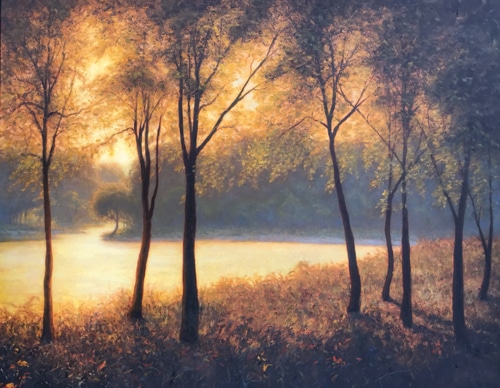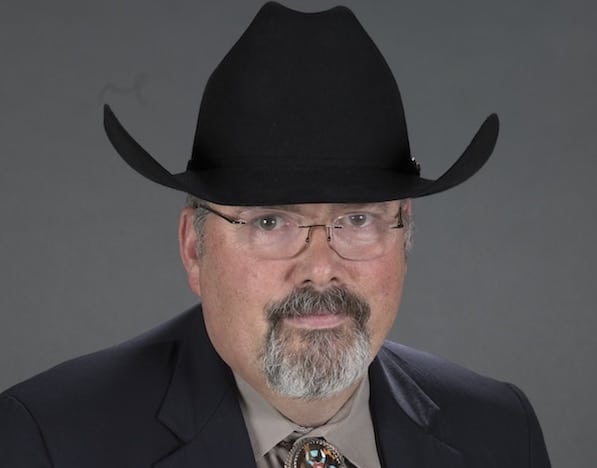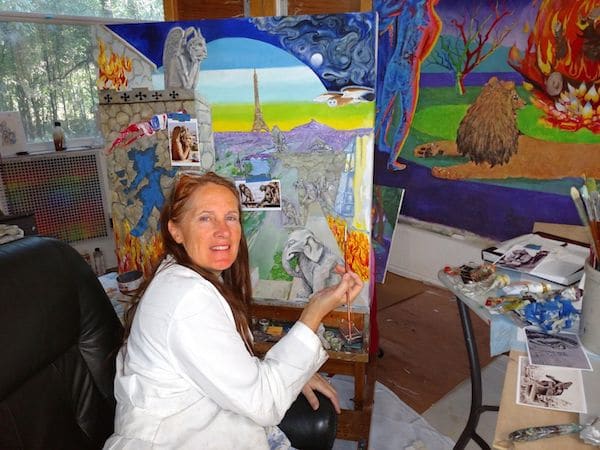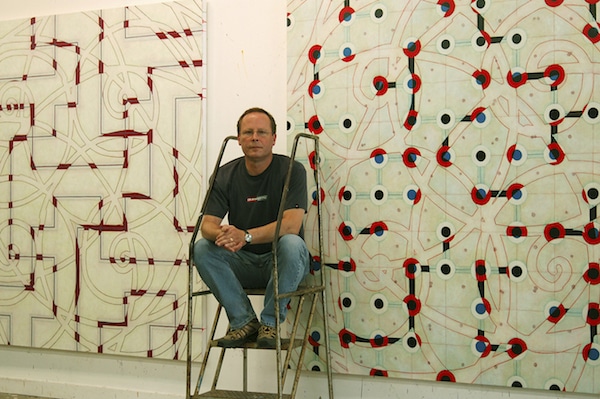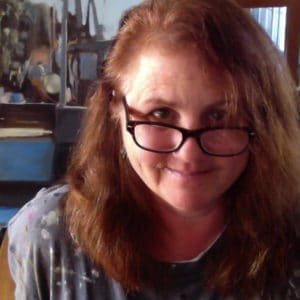 2017 Accelerator Fellow
2017 Accelerator Fellow
Where did you grow up?
I was born in Rhode Island, but I grew up in Rehoboth, Massachusetts, a small town near the coast, between Providence and Boston. I attended a regional high school that had a serious arts program. I also grew up without the Internet, cell phones, and all of today’s groovy gadgets, which meant that I actually went out and played, painted, and created. It was a different time.
When/how did you first know that you wanted to be an artist?
I never really wanted to BE an artist; I just am one. I could always paint, draw, and turn a mess into something beautiful, which was a common skill in my family. I see my art as blue-collar and work-oriented, and consider myself a painter, as opposed to an artist.
I prefer to recognize the art in everything that’s around me and help others do the same—to slow down, unplug, and enjoy where they are. I am someone who looks at life creatively AND studies painting.
Where do you currently live/work, and how would you describe the arts community there?
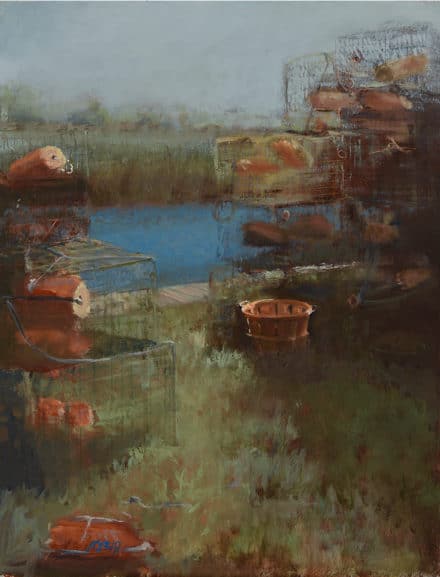
I live in the small coastal town of Beaufort, North Carolina. It used to be a vibrant fishing community and still is, though to a lesser extent, but now it’s also a seasonal tourism destination. There is a small arts community here where crafts and woodworking prevail, and we have an arts council (no building, but some volunteers). I like to think that it is growing. I’ve created my own community with other area artists—painting together en plein air, or inside with a model—but it’s all a bit loose and inconsistent.
How would you describe your art to someone who’s never seen it?
I am a representational oil painter who works in a traditional manner with knives and brushes. I paint on wooden or clay panels, which are easier to store, frame, and show in a high-humidity environment than canvas or paper.
When I create a scene, I like to use bold shapes and a subtle color palette, and I am happiest with a balanced composition. I work in series that last a year or two, each one building on those that preceded it. Currently, I am concentrating on local seascapes and maritime subjects.
What do you hope to communicate to your audience?
I am not a message painter, and I don’t impose ideology on my work, but I do hope to create a moment in time and space that seems to last forever and that could also disappear in an instant. When someone sees my work, I hope they feel it. I want it to be comfortable, like good shoes or old jeans. Hopefully, they observe my painting and settle into it, visiting and re-visiting it as they would an old friend.
What’s been your biggest business challenge?
I want to paint more, but I am also trying to set up a profitable business, and there are many administrative tasks to learn. I consider myself a start-up—everything is new, which means that I need to create systems for doing all of it.
Tell us about a business success and what you did to achieve it.
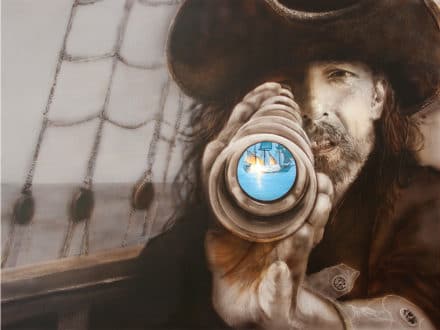
After I first moved to Beaufort, I took a job at a local bar, where I met a tremendous number of people. I also participated in many local events and taught classes at the NC Maritime Museum, though no one knew I painted.
When I began to work as a professional painter, I decided to introduce my art to the town by staging a one-person show. Beaufort is a place that’s known for its pirate history—it was a favored haunt of Blackbeard’s—so I painted a signature piece for the show that depicted a pirate about to go into battle.
I timed the exhibition to take place during the town’s annual Pirate Invasion event, rented a space, secured a caterer and wine/beer sponsors, and recruited volunteers to help. I also printed posters of the painting to raise money for the town. I wrote an article for the local paper, hung advertisements, and went door-to-door, visiting local businesses to re-introduce myself as an artist. The event drew more than 700 people, which was basically all of Beaufort, and I sold the original painting before the show even opened, as well as selling out all the charity prints and much of my existing inventory.
How do you feel about today’s technology (tools for your business, for creating your art, or both), and has it altered your way of doing business?
I am a fairly old fashioned—what these days would be referred to as “old school”—so technology does not affect my painting very much, but It does help me scout locations, find supplies and reference materials, and make travel plans. It’s also a great tool for learning new skills and conducting research.
Since I’m not at all “into” social media, I am lucky that most of the folks who are interested in my painting are older, enjoy making a personal connection, and are not too techy. I definitely prefer the real world to the virtual one.
What do you think about the state of today’s art market?
I was not part of the “art scene” before 2008, back when things were good (according to what others have told me). Since then, galleries have been closing or limiting what they do for artists, so things seem to be getting tighter. Many artists express frustration with gallery rules and are leaving galleries behind to sell their work independently. That’s great, but whether these artists succeed or not will depend on the type of market they’re attempting to reach.
My customers tend to be more traditional in their purchasing habits and less involved with technology—my buyers like to see and experience a painting before purchasing it—so gallery representation is the best way for me to expand that audience. I would, however, love to add online sales to the mix, as a way of reaching millennials.
Give us an example of how you balance studio time with business time.
I work in cycles. Sometimes, I’m heavy into painting and light on administrative work. Other times, it’s the reverse. Regardless, I try to dedicate whole days to each area. During a painting cycle, I might allocate four full days to studio work, a day for physical errands, a day for computer work, and a free day. I try to be as flexible as possible, which allows me to put out fires, meet deadlines, or follow through on an unexpected opportunity when it arises. I change my work plan on a quarterly basis to fit my production cycle.
How have you evolved as an artist?
I went to college, but it wasn’t a good fit for me. My art was not in line with the Abstract Expressionism that was happening at the time, and it seemed that there was no other way to approach an arts education. Looking back on it now, I think geography was the limiting factor. The Internet has opened up educational opportunities like nothing else. You can learn almost anything online.
My career has evolved in a dotted line that might look to some like a pile of spaghetti. After getting my degree, I stopped painting for the public and got a “real job,” painting only for myself. However, I could not deny how much I loved painting, and with the resurgence of realism, I am much happier in the art field. So here I am, embarking on an art career a bit later in life, and this is how I plan to live going forward.

How have you evolved as an entrepreneur?
I enjoy working for myself and being responsible for my own success. When I started, I did not see art as a business and was never taught that it was. I didn’t understand all the facets of selling back then, but it does not take long to learn something when you must. While you’re actually painting, it is art—a growing and learning experience—but after you’ve finished a painting, I find it helpful to think about it as a product, and that is not easy to do. I still want my paintings to go to a loving home.
What role do artists play in our society? What role SHOULD they play?
Artists’ roles have changed so much over time—from craftsmen (blue collar), to professional (white collar), to small business owners and entrepreneurs (no collar)—and they will continue to evolve. There are so many different types of artists and definitions of art, and that is exciting. It is up to the artists to decide their path and how they want to fit into the world.
For more information on Donna Lee Nyzio, see her official CHF bio.




